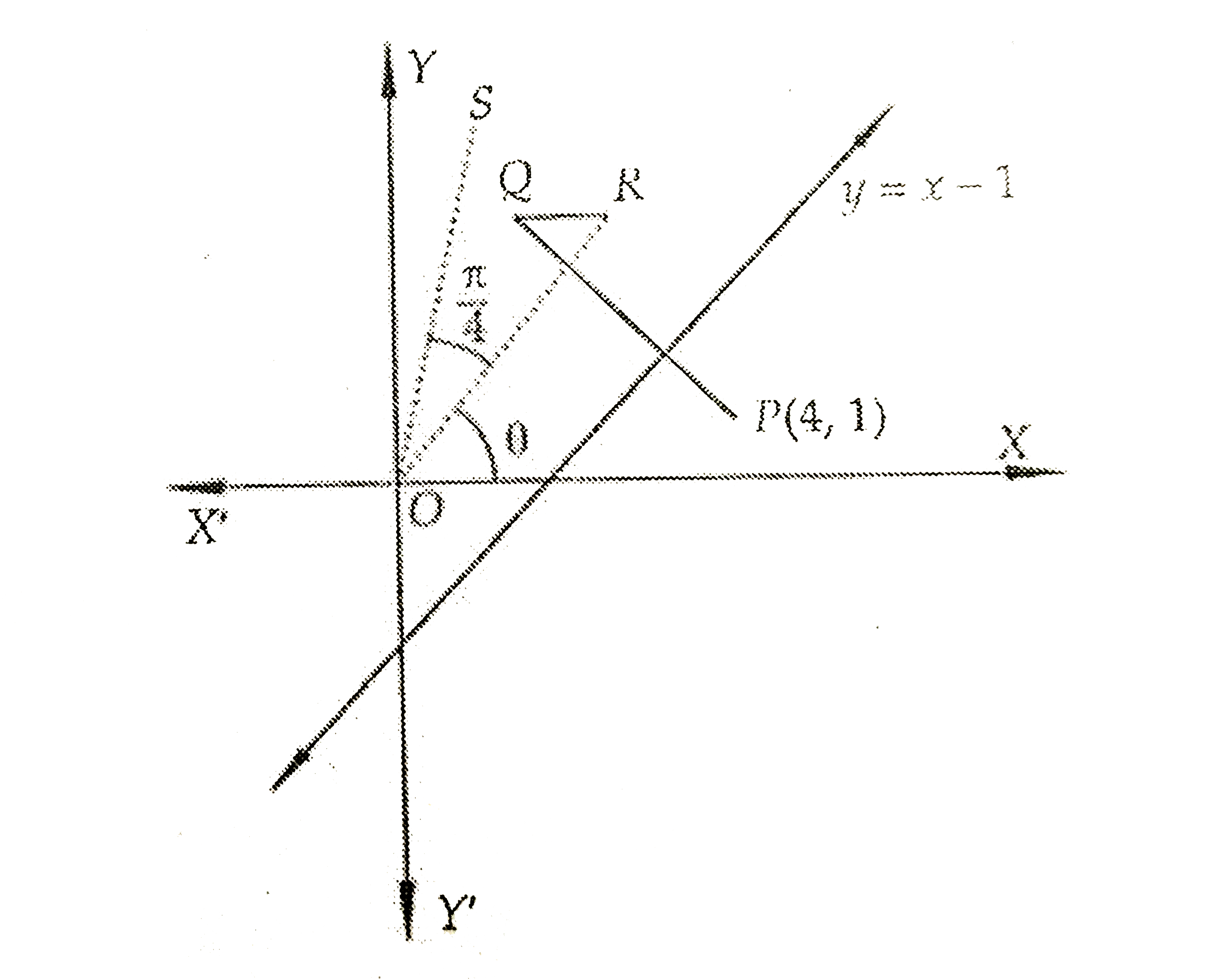The point (4, 1) undergoes the following three transformations successively: (a) Reflection about the line y = x (b) Translation through a distance 2 units along the positive direction of the x-axis. (c) Rotation through an angle π4 about the origin in the anti clockwise direction. The final position of the point is given by the co-ordinates.
(2,3)
(2,3√2)
(0,3√2)
none of these
The correct Answer is:C
Let Q (x1,y1) be the reflection of the point P(4,1)in the line mirror y=x-1. Then, the coordinates of Q are given by
x1−41=y1−1−1=−2(4−1−1){12+(−1)2}
⇒x1−41=y1−1−1=−2⇒x1=2,y1=3
Thus, the coordinates of Q are (2,3)
Now, Q is translated parallel to x-axis in the positive direction by 1 unit. So, the coordiantes of R aer (1+2,3) or (3,3) .
Suppose OR makes an angle θ with OX.Then,
tanθ=33=1⇒θ=π4
It is given that OR is rotated through π4 in anticlockwise sense to coincide with OS. Therefore, OS makes a right angle with OX and OS =OR=3√2 .
Thus, the coordiantes of S are (0,3√2).

Topper's Solved these Questions
Similar Questions
The point (1,3) undergoes the following transformations successively (i) Reflection with respect to the line y=x (ii) translation through 3 units along the positive direction of the X-axis (iii) Rotation through an angle π6 about the origin in the clockwise direction. The final position of the point P is
View SolutionThe point (3, 2) undergoes the following transformations successively
(i) Reflection with respect to the line y=x
(ii) translation through 3 units along the positive direction of the X-axis
(iii) Rotation through an angle of π6 about the origin in the clockwise direction. The final position of the point P is
View Solution
Knowledge Check
The point (4,1) undergoes the following three transformations successively
(i) Reflection about the line y=x
(ii) Transformation through a distance 2 units along the positive direction of x-axis
(iii) Rotation through angle π/4 about the origin in the anticlockwise direction. The final position of the point is given by the coordinatesA(1√2,7√2)B(−2,7√2)C(−1√2,7√2)D(√2,7√2)The point P (a,b) undergoes the following three transformations successively :
(a) reflection about the line y = x.
(b) translation through 2 units along the positive direction of x-axis.
(c) rotation through angle π4 about the origin in the anti-clockwise direction.
If the co-ordinates of the final position of the point P are (−1√2,7√2) , then the value of 2a−b is equal to :A13B9C5D7The point (4,1) undergoes the following three successive transformations ,
reflection about the line y=x−1
translation through a distance 1 unit along the positive direction
rotation thrpough an angle π4 about the origin in the anti - clockwise direction
Then the coordinates of the final point are ,
A(4,3)B(72,72)C(0,3√2)D(3,4)
The point (3,2) undergoes the following three transformations in the order given (i) Reflection bout the line y=x (ii) Translation by the distance 1 unit in the positive direction of x-axis (iii) Rotation by an angle π4 about the origin
View SolutionThe point A(4, 1) undergoes following transformations successively:reflection about line y=x translation ,through a distance of 3 units in the positive direction of x-axis(iii) rotation through an angle 105∘ in anti-clockwise direction about origin O.Then the final position of point A is
View SolutionThe point (7,5) undergoes the following transformations successively (i) The origin is translated to (1,2). (ii) Translated through 2 units along the negative direction of the new X-axis (iii) Rotated through an angle about the origin in the clockwise direction. The final position of the point (7,5) is
View SolutionThe point (4,1) undergoes the following two successive transformations
(i) Reflection about the line y=x
(ii) Translation through a distance 2 units along the positive X-axis.
Then the final coordinate of the point are
View SolutionThe point P(a,b) undergoes following transformation to a new co-ordinate P'(−1√2,7√2)
(i) Reflection about y=x
(ii) Translation through 2 unit in the positive direction of x-axis
(iii)Rotation through an angle π4 in anti-clockwise sense about the origin
Then the value of 2a−b is
View Solution
